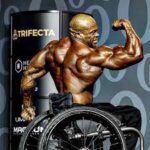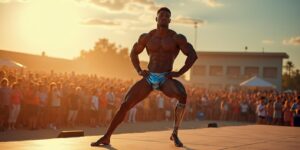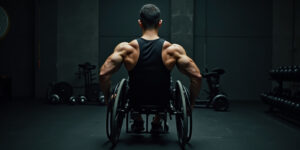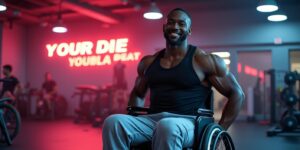Understanding the Wheelchair Olympia: A Brief Overview
The Wheelchair Olympia is a bodybuilding competition for athletes with disabilities. It is held annually by the International Federation of Bodybuilding and Fitness (IFBB) as part of the Mr. Olympia weekend. The first Wheelchair Olympia was held in 2018, and Harold Kelley of the United States has won the title every year since. The Wheelchair Olympia is open to athletes who have suffered an injury or congenital disorder that requires them to use a wheelchair. The competition is judged from the waist up, and athletes are scored on their muscularity, symmetry, and stage presence. In addition to the overall title, there are also awards for the best in each weight class. The weight classes are:- Up to 165 pounds
- 165-180 pounds
- 180-195 pounds
- 195-212 pounds
- Over 212 pounds
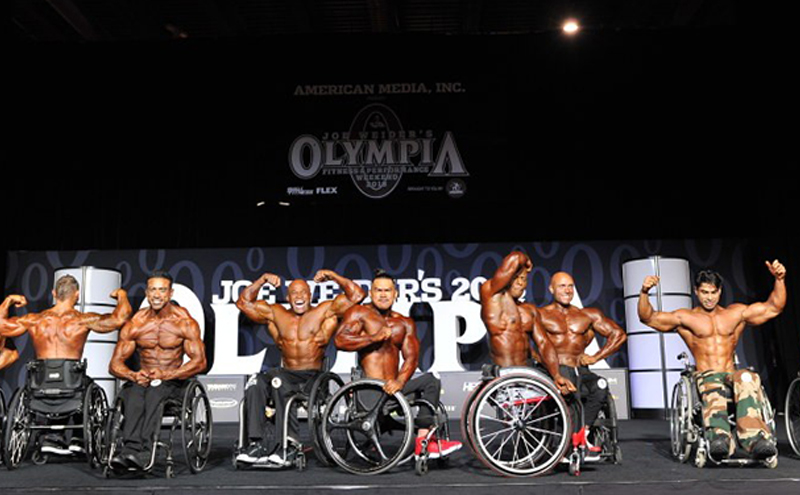
History of the Wheelchair Olympia
The Wheelchair Olympia is a bodybuilding competition for wheelchair users that is held annually as part of the Mr. Olympia weekend. It was first held in 2018, and the inaugural champion was Harold Kelley of the United States.
The idea for the Wheelchair Olympia was conceived by Nick Scott, a former professional bodybuilder who became a quadriplegic after a car accident in 2008. Scott was inspired by the success of the wheelchair division at the Arnold Classic, and he wanted to create a similar competition that would showcase the athleticism and determination of wheelchair bodybuilders.
The Wheelchair Olympia is open to men and women of all ages and abilities. Competitors are judged on their muscularity, symmetry, and stage presence. The competition is divided into two divisions: men’s open and women’s open.
The Wheelchair Olympia has quickly become one of the most prestigious bodybuilding competitions for wheelchair users. It has helped to raise awareness of wheelchair bodybuilding and has inspired other athletes to pursue their dreams.
Here are some of the winners of the Wheelchair Olympia:
- 2018: Harold Kelley (United States)
- 2019: Gabriele Andriulli (Italy)
- 2020: Harold Kelley (United States)
- 2021: Antoni Khadraoui (Algeria)
- 2022: Harold Kelley (United States)
The Wheelchair Olympia is a testament to the power of the human spirit. It is a reminder that anything is possible if you set your mind to it.
How to Prepare for Wheelchair Olympia: Training Techniques?
Preparing for the Wheelchair Olympia, or any competitive wheelchair sport, requires dedication, a well-structured training plan, and a focus on both physical and mental aspects of performance. Here are some training techniques and tips to help you prepare:
Consult with a Coach or Trainer:
- Start by seeking guidance from an experienced coach or trainer who specializes in wheelchair sports. They can help you develop a personalized training plan and provide valuable insights.
Set Clear Goals:
- Define specific, measurable, and time-bound goals for your performance at the Wheelchair Olympia. These goals will help you stay motivated and track your progress.
Strength and Conditioning:
- Wheelchair athletes need strong upper-body muscles, especially in the shoulders, chest, back, and arms. Incorporate strength training exercises such as bench presses, rows, pull-ups, and push-ups.
- Focus on endurance training to build stamina and cardiovascular fitness. Wheelchair racing, hand cycling, and swimming can be effective for this purpose.
Sport-Specific Training:
- Spend ample time practicing the specific disciplines of the Wheelchair Olympia, such as wheelchair racing, basketball, or tennis.
- Work on your agility, speed, and technique. Drills and interval training can help improve your performance in these sports.
Flexibility and Mobility:
- Maintain flexibility through regular stretching and mobility exercises. This will help prevent injuries and improve your overall performance.
Nutrition:
- Proper nutrition is crucial for any athlete. Consult a nutritionist to create a well-balanced diet that supports your training and recovery needs.
- Stay hydrated to optimize your performance and recovery.
Rest and Recovery:
- Give your body enough time to rest and recover. Overtraining can lead to injuries and hinder your progress. Quality sleep is essential for recovery.
Mental Preparation:
- Develop mental toughness and focus through visualization, meditation, and mindfulness techniques.
- Practice dealing with pressure and anxiety by simulating competition conditions in your training.
Equipment:
- Ensure that you have the right equipment, such as a well-fitted wheelchair and sports-specific gear.
- Regularly maintain and inspect your equipment to avoid any issues during competitions.
Competition Experience:
- Participate in local and regional wheelchair sports competitions to gain experience and build confidence.
- Analyze your performance after each competition to identify areas for improvement.
Seek Support:
- Surround yourself with a supportive team, including coaches, physical therapists, and fellow athletes. They can provide motivation and guidance.
Adaptability:
- Be prepared to adapt to changing conditions and challenges during the competition. Mental flexibility and the ability to adjust your strategy can be crucial.
Remember that consistent training, dedication, and a positive mindset are essential for success in wheelchair sports like the Wheelchair Olympia. Additionally, it’s essential to consult with healthcare professionals and specialists to ensure your training plan aligns with your specific needs and abilities.
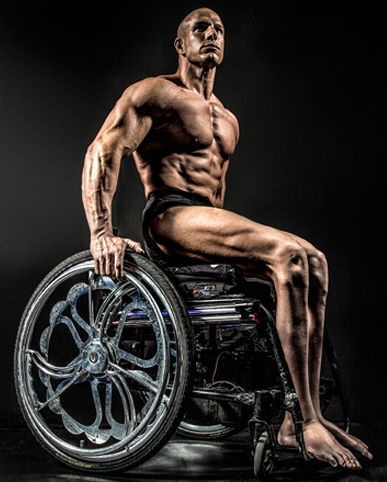
Nutritional Guidelines for Wheelchair Olympia Competitors
Here are some nutritional guidelines for wheelchair Olympia competitors:
- Eat a balanced diet that includes plenty of fruits, vegetables, whole grains, and lean protein.
- Aim to eat 3-4 meals and 2-3 snacks per day.
- Don’t skip breakfast, as it is the most important meal of the day.
- Drink plenty of fluids, especially water.
- Eat a high-carbohydrate diet on the days leading up to competition. This will help you to store glycogen, which is the body’s main source of energy.
- Eat a moderate amount of protein on the days leading up to competition. This will help to repair muscle tissue.
- Eat a light meal or snack 2-3 hours before competition. This will give you energy without making you feel too full.
- Stay hydrated during competition by drinking water or sports drinks.
- Eat a recovery meal or snack within 30 minutes of finishing competition. This will help to replenish glycogen stores and promote muscle repair.

Judging Criteria
When evaluating competitors in the Wheelchair Olympia, judges consider overall physique, symmetry, posing technique, stage presence, and adherence to rules.
Case Study: Harold Kelley’s Winning Streak at Wheelchair Olympia
Case Study: How Harold Kelley’s Dedication and Training Led to Victory at Wheelchair Olympia.
- Harold Kelley’s Training Regime
Harold Kelley’s comprehensive training regime included weightlifting, cardiovascular exercises, and functional training for overall strength and balance. Progressive overload and periodization techniques were used to challenge his muscles. Flexibility and mobility exercises were incorporated to prevent injuries and maintain performance. Tracking progress and adjusting the training plan were integral to Kelley’s success.
- Lessons from Harold Kelley’s Success
Consistency, dedication, realistic goals, learning from failures, support network, positive mindset—key lessons from Harold Kelley’s success.
Preparing for Wheelchair Olympia 2023: What’s New?
Get ready for Wheelchair Olympia 2023 by staying updated on the latest rule changes and regulations. Look out for advancements in training techniques and technologies to enhance your performance. Research the predicted competitor lineup and connect with other athletes on social media platforms. Attend workshops and conferences to gain insights from experts and stay ahead of the curve.
Expected Changes in Rules
Anticipate modifications in judging criteria, mandatory poses, weight classes, and drug testing protocols. Adapt game plans accordingly.
What makes a Wheelchair Olympia champion?
Achieving success in Wheelchair Olympia requires a unique combination of strength, skill, and unwavering determination. Champions demonstrate exceptional physical abilities, but it’s their mental fortitude that sets them apart. Strict training regimens and proper nutrition are crucial for peak performance. Wheelchair Olympia champions inspire others with their dedication and passion for the sport.
Perseverance overcomes obstacles, determination fuels the drive to push limits, and mental resilience keeps athletes motivated, inspiring others never to give up.
Let’s Sum Up
In conclusion, becoming a champion in Wheelchair Olympia requires a combination of physical strength, endurance, proper nutrition, and mental preparation. Understanding the history and rules of the competition is essential, as is mastering the wheelchair techniques through dedicated training. Building a winner’s mindset and overcoming performance anxiety are crucial for success. Additionally, studying the strategies of past winners, like Harold Kelley, can provide valuable insights.
As Wheelchair Olympia continues to evolve, competitors should stay updated on the expected changes in rules and the predicted competitor lineup for upcoming competitions. Ultimately, it is the perseverance and determination of the athletes that sets them apart and makes them champions in the Wheelchair Olympia.

